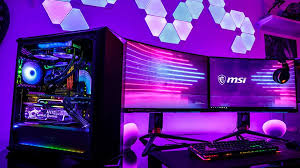Visual clarity has become one of the most overlooked elements in modern gaming.
While players often focus on FPS, refresh rate, or latency, the way colors appear on-screen
can dramatically affect reaction time, immersion, and overall comfort during long sessions.
This is where tools like VibranceGUI have become essential.
Why Color Vibrance Matters
Many PC games ship with muted or low-saturation color profiles.
Developers do this for consistency across hardware, but it often results in washed-out visuals—especially on TN or older IPS panels.
Increasing vibrance makes key elements easier to distinguish:
- Enemy models stand out more clearly in competitive shooters
- UI elements become easier to read on ultrawide or high-resolution monitors
- Environmental objects gain depth and contrast without artificial sharpening
- Players experience reduced eye strain since important information “pops” more naturally
The result is a gameplay environment that feels sharper, cleaner, and more responsive without touching your GPU or monitor settings.
The Role of System-Level Color Control
What makes VibranceGUI so popular is that it applies color changes at a system level.
Unlike in-game saturation sliders—which vary wildly between engines—VibranceGUI delivers:
- Consistent vibrance across all titles
- Automatic profile switching when you open or close a game
- Reliable behavior even when games launch in exclusive fullscreen
- No performance penalty, since software-level vibrance costs virtually no resources
This lets competitive players maintain identical visual profiles across shooters, MOBAs, MMORPGs, emulators, and even older game clients.
Why MMORPG Players Also Benefit
It’s not only FPS players who see real improvements. MMORPG communities—especially those playing classic or retro-style titles—often deal with flatter color palettes and low-contrast models.
For example, players in classic-inspired games and projects such as
community-driven RSPS servers frequently report that terrain textures, item icons, and interface elements become far easier to distinguish when vibrance is properly tuned.
Sharper colors can help during long PvM sessions, bossing encounters, or even marketplace trading where visual clarity matters more than players expect.
Finding the Right Vibrance Settings
While every setup is different, most players settle on a few common guidelines:
- 60–70% vibrance for competitive shooters to highlight silhouettes
- 40–55% vibrance for MMORPGs and RPGs with bright worlds
- Lower vibrance for dark games like survival horrors to avoid overexposure
- Custom per-application profiles for specific games
Experimenting is key. What looks perfect on one monitor may be too intense on another, so it’s best to adjust gradually until the balance feels natural.
The Future of Color Optimization for Gaming
As graphics engines evolve, color processing continues to become more complex.
Tools like VibranceGUI offer a simple, user-friendly way to maintain full control over your visual experience without modifying game files or relying on GPU-specific software.
Whether you’re climbing the ranks in competitive shooters or exploring classic-style online worlds such as oldschool RSPS servers, enhanced vibrance helps create a cleaner, more immersive gaming environment.
In short: better colors mean better gameplay—no matter what genre you play.
